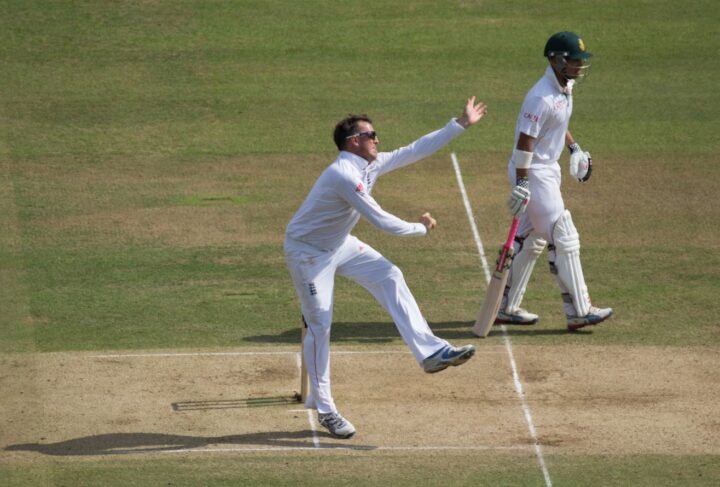A quick update from Cape Town before I reveal the very obvious answer to the question about four-day tests above. Apparently Jofra Archer has been struggling with a sore elbow – previously diagnosed by England’s management team as a sore arse – and therefore he might not be fit for the second Test against the Cricket Boks.
This is bad news for England, who desperately need Archer’s pace, but something tells me that Silverwood and Co might be slightly relieved if Jofra can’t play. It means they can dodge that awkward question of whether to drop Broad (or even Anderson) to accommodate a spinner. Knowing England, however, they’ll probably just replace Archer with Overton and go into the match with 5 fast-medium seamers instead.
Anyway, back to today’s main topic. We heard on New Year’s Eve – always a decent day to bury bad news – that the ECB ‘cautiously’ supports the introduction of four-day tests. Why? Because they say it will ease the strain on players and create breathing room in the international schedule.
Pull the other one guys. Absolutely nobody is buying this. The last thing the ECB has cared about over the years is player welfare. And as for creating some much needed space in the international schedule, it’s escaped nobody’s attention that the ECB, ACB, and BCCI are currently trying to force through an annual ODI tournament between the big three nations.
Basically if you’re trying to find space for a new money-spinning ODI competition, and the calendar is looking rather tight, shaving a day off Test matches (which would save England approximately 12 days per year) seems like an pretty effective solution.
Let’s ‘do the math’ here. Four-day Tests would save England approximately 12 days per year (that’s if all Tests went to a fifth day, which only about 40% do). But the remaining days would be longer – expanded from 90 overs to 98 overs. Therefore Joe Root, for example, would save about 5 days playing time (40% of 12 days), but gain just over an extra day’s work because he’ll be playing 108 overs per year more. So overall he’s saving just under 4 days on the field.
Now throw in the new big three love-in tournament, which would inevitably involve a number of white ball fixtures (I’d politely suggest far more than 4) plus lots of extra travel if it’s down under or in India. And yet we’re supposed to believe that player welfare is at the top of the ECB’s agenda? Excuse me while I tighten my corset for I fear that my sides might be splitting.

I wrote in my New Year’s article celebrating ten years of TFT that the biggest existential threat to Test cricket is actually the administrators who are supposed to be custodians of the game. This plan to reduce the pinnacle of the sport from five days to four is a prime example.
Yes Test cricket has some problems at the moment. Crowds in some parts of the world are not what they should be. What’s more, there are too many lifeless surfaces that produce bland cricket. However, reducing games from 5 to 4 days makes no sense as a solution to the format’s problems. After all, when are wickets most likely to fall? On the 5th day when pitches have deteriorated most.
Rather than reducing the length of matches – which might encourage more teams to play for the draw (especially if there’s bad weather around) – surely it would be better to simply produce better pitches or use different balls (exchanging Kookaburra’s for Dukes for example).
What’s more, the impact of recent innovations introduced to boost Test cricket – i.e. day-night Tests and the World Test Championship – haven’t even been assessed yet. Day-night Tests have proved very popular thus far, whilst the WTC has only just begun. Surely it’s ridiculous to even consider altering the length of games before these measures have had time to marinade?
It’s all so sad. Can you imagine golf reducing majors from four days to three in order to make room for more big match challenges sponsored by investment banks? The whole concept seems completely over the top.
Although (in theory) introducing four-day Tests might lead to more attacking cricket as teams try to score quickly and force a result, I’m not convinced this will actually happen in reality. Underdogs, for example, might have one eye on survival from the start. This could lead to more negative fields as captains try to contain the opposition, and more negative batting as occupation of the crease becomes an end in itself.
What’s more, if groundsmen continue to produce a plethora of lifeless drop-in surfaces, the stronger teams might abandon hope of forcing a result sooner. We might also see more contrived finishes set up by declaration bowling.
The truth, of course, is that nobody knows exactly what will happen. However, it seems to be that Test cricket would need to be completely broken to justify such a drastic change. And that’s simply not the case. All forms of cricket have their strengths and weakness and, on balance, Test cricket remains the best form of the game.
This year’s Ashes series was the perfect illustration. Three of the five Tests went the 5th day and produced some exhilarating cricket. I’d also worry about the effect four-day Tests would have on spinners. After all, the final day is when slow bowlers come into their own on worn surfaces.
The only justification for reducing the length of Test matches seems to be financial. Test matches can be expensive to host, and less affluent countries do worry about the costs. However, a better solution would be to spread cricket’s wealth more equitably rather than mess with decades of history. Unfortunately, however, the big three aren’t exactly known for their altruism.
When ODI’s started to become formulaic they experimented with power plays, smaller boundaries, and introduced a new ball at each end. They didn’t simply shave off ten overs and make the contests 40 overs rather than 50. So why should Test cricket have to surrender its soul as a first, rather than last, resort?
There is the argument, of course, that change is inevitable. Perhaps we’re just a bunch of cantankerous old fuddy-duddies howling into the wind. Perhaps we should listen to the likes of Jos Buttler:
I think the administrators and broadcasters have got to look at the best way to preserve Test cricket. It’s the best form of the game, so how can we maintain that and keep moving the game on? If that’s the option, moving it to four days, that has to be looked at. I like that it’s five days, when you get a fantastic Test that finishes on day five with all three results possible there’s nothing else really like that in cricket. As with everything times change, things change, and the game has to evolve with that. Everyone has to be open to change if that’s what is needed.
This for me sums up the whole debate. Thoroughly modern Jos admits that Test cricket is ‘the best form of the game’ and that 5 days produces ‘fantastic finishes’ and ‘there’s nothing else like it’. And yet he still thinks we should consider sacrificing all that. Why? Because apparently fundamentally changing something that’s bloody brilliant is the best way to keep it bloody brilliant.
It. Just. Makes. No. Sense.
James Morgan









The idea of increasing the overs per day to 98 is just nonsense – 90 rarely get completed in a typical day’s Test cricket.
Maybe it is time for a revolt, don’t attend the white ball stuff, meaningless tournaments to raise yet more income for the already filthy rich and let us kill what makes Test Cricket, test match cricket. Those in charge should be charged with crimes against our sport and checking for receiving bungs! No person who genuinely cares for our game would support such a suggestion.
Sadly the majority who attend white ball are beer heads and corporates who don’t give a crap as it’s just there as a day out to get leathered. Plus, the poorer people who cns only afford one ticket will always choose a white ball game..
You’ll never get it boycotted .. jus trike people don’t boycott he extortionate money charged by banks for loans , car prices to normal people compared to business or maybe insurance rip offs etc etc
I saw that interview with Jos and I thought he was very diplomatic in his response, as he no doubt felt he needed to be. Others have been more outspoken.
Day/night tests have been well-attended but every day the match has changed dramatically in the last session with the pink ball swinging around corners.
Innovations like the toss experiment in county cricket could be tried in tests.
The cricketing authorities’ approach seems to be – introduce something that is unpopular and eventually people will get used to it. To hell with the consequences as long as it brings cash to the short-term coffers.
The Ganguly tournament will eat time, which has to come from somewhere (if you are the ECB). It is nonsense in boots, of course. The other thing is saving fifth day costs, and avoiding the sag in viewing figures in the 25% of Tests when the match doesn’t go into the fifth day. But the cricket justification of all this is predictably as wrong as it is weaselly. They know that. We know that. Nothing changes in the relentless march to the bottom.
Don’t blame Jos or the other England players – given they’re on central contracts, you can’t expect them to deviate from their employer’s line.
I share your cynicism though – this is about money, as it always is when the ECB are involved. It would make it much easier to play back to back Tests, and fit yet more pointless white ball series in. Any suggestion it’s about player welfare is purely a smokescreen.
This kind of managerialism has been everywhere for several decades – but only more recently in sports. It isn’t really about money (or else they would not be be throwing money down the mineshaft that is womens’ cricket), it is about senior managers careers.
Managers *change* things – it’s what they do; and they get status, salary and promotions for devising and implementing changes. When a senior manager applies for a new job, he points at what changes he has recently made in the previous organisation (and it is always too early to know whether these changes helped or made things worse). Managers don’t wait to see how things will work out, they don’t evaluate the changes – the next generation of managers just devise and implement *more* changes.
At any rate this has been my experience from several decades working in large organisations. If I am right, this is just the beginning. As the international cricket managerial structure continues to get more powerful, they will make more, and more, changes.
Very true Mr Charlton.
I remember getting a very sneery response from Lord MacLaurin during a phone-in after England’s disastrous world cup in 1999 when I raised concerns about, among other things, making the domestic one-day competition 45 and not 50 overs.
His response: “It’s as near as dammit.”
https://www.telegraph.co.uk/sport/columnists/scyldberry/2400843/Lord-MacLaurin-why-I-quit.html
https://www.telegraph.co.uk/sport/columnists/scyldberry/2400843/Lord-MacLaurin-why-I-quit.html
A fair point about ‘managerialism’ – in this case by marketing clowns. It is why, when I was a company director, I regarded giving the marketing department a huge training budget an excellent investment. If they were off training they could do less damage to the company.
Not, it would appear, Chris Silverwood. Same old, same old from England in Cape Town.
Let’s ‘do the math’ here.
On a lighter vein, cricket, being a thoroughly English game requires that proper English be used when writing about the game. In English, as opposed to the mumbo-jumbo they speak on the other side of the pond, the correct abbreviation for mathematics is “maths”, not “math”!
‘Do the maths’ is a cliche. ‘Do the math’ is an even bigger cliche. I used the American version for emphasis – hence the inverted commas :-)
Very appropriate, given the rampant commercialisation of sport – no better demonstrated than at the Super Bowl.
Well let us “take the positives going forward”. One day less to watch England playing
Ike tits in a trance….
Why not have one day Test matches and be done with it?
It’s interesting to note that, when players were asked about this (see Cricinfo), current test players we “open to the possibility” whereas players who were not beholden to their Boards (Philander, McGrath) said “no way”. One of the few current players to say he did not want 4 day tests was Nathan Lyon.
The problem with “change” or in business “restructuring” is that is mainly done to justify managers high salaries, and more often than not does not improve productivity or services, and pisses off the work force, or fan base in our case. Generally speaking it comes back and bites you up the bum. So ECB watch out.
My old boss used to say that there were about 4 ways to restruct a local government department or directorate before you end up where you started. 30 years in local government showed me this is basically true.
4 day test cricket was the order of the day not so long ago, when pitches were uncovered and ill prepared.
5 day tests were the result of better pitches needing more time for matches to complete 4 innings.
With today’s white ball overkill undermining red ball techniques, many tests are completed in 4 days and under anyway. Also as this is the duration of county and state matches it seems to make more sense if you are going to use these as breeding grounds for test players to emerge. It would also stop the toss being so important on occasions when pitch deterioration makes batting a lottery on day 5.
All that said totally agree the ECB argument lacks any credibility. Burn out has never been their concern.
Money money money money and more money
Changing the subject, yet again we have a player – Rory Burns in this instance – ruled out of a tour after an injury playing football! When will they learn?
They don’t learn so jut expect it to be chalked up to bad luck and things to continue as usual
But good to see that they perform like real footballers. I still recall with awe the season about 15 years ago when West Brom lost one player for a month with a sprained ankle after being tackled by a cone in training, another who had his metatarsal broken by a teammate jumping on it in celebration after a goal, and the loss of 3 players for 2 weeks due to inflamed eyes after the groundsman spread fertiliser on the training ground.
Football seems to now be banned in training. That creaking sound is probably stable doors shutting after horses have bolted.
It is impossible to separate the potential demise of 5 day test cricket from the rise of white ball – but not because of the money aspect and need to free up more time for white ball (although that may be the motivation of the mafiosi running cricket). The issue is the demise of cricketers who can play test format cricket. White ball has produced a dominant batting style more akin to baseball with the result that fewer tests last the full distance despite the dramatic fall in over rates over the years. The concepts of seeing off the new ball, building an innings or batting out a fourth innings for a draw have all been sacrificed to the instant gratification of a quick 30 or 40. Whilst there have been honourable recent exceptions to this trend (Dravid, Cook, Kallis spring to mind) they are becoming ever rarer.
If these trends continue we will be regarding 50 over games as the long form and calling them tests in 20 years time.
It can’t be true both that having 4-day Tests mostly won’t affect results and they’ll significantly reduce players’ workload:
• If a Test match finishes within 4 days, then it also would’ve finished in 5, so there’s no difference in the workload.
• The only way a 4-day Test match can involve fewer overs than a 5-day Test is if the match is abruptly curtailed at the end of 4 days, resulting in a draw. If the player workload reduction is meaningful, then we must be having a significant number of draws.
4-day advocates could plausibly make one claim or t’other (4-day Tests will be cheaper and largely won’t affect results, or 4-day Tests will reduce player workload, and more draws is the price of that). But claiming them both at once is so contradictory that it undermines any point the proponents might have had.
It was good to see Paul Newman, Lawrence Booth and Nasser Hussain all coming out strongly against the idea. Sky published an article that looked to the casual observer Root had backed four-day Tests but read it carefully and he hadn’t – he was supporting it for Tests like the Ireland game but not for all Tests which was exactly the key point in the ECB announcement, that they want four days mandatory for all Tests.
98 overs a day is clearly a joke given modern over rates and the lack of any action to tackle them over several years. As for the effect on the game, I’m not so much worried about more draws but that shoddy pitches will become the norm as groundsmen feel the pressure to produce result pitches. Team scores of 300+ and individual centuries could become the exception. The fact that this is how England are playing anyway is of course entirely coincidental. I don’t agree with using the Duke ball – Australia get results with the Kookabura no problem and Shaun Pollock said during the first Test that when they trialled the Duke in SA
it was a disaster (although he did also say it was the white ball Duke). The Duke ball deteriorates very quickly on abrasive surfaces which is why it isn’t used in the first place.
On other matters, this Archer “injury” is extremely convenient. If it’s genuine, playing him in both Tests in NZ with sluggish surfaces and no WTC points at stake looks even dafter. As for Overtom, he’s been placed entirely under ECB control (with Stone and saqib) and they think he can be turned into a 95mph bowler in his late 20s. What could possibly go wrong?